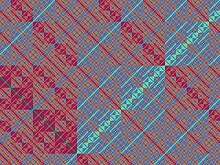Richard Hamming
Richard Wesley Hamming (born February 11, 1915 in Chicago , Illinois , † January 7, 1998 in Monterey , California ) was an American mathematician whose work had a great influence on computer science and telecommunications .
Life
Hamming was born in Chicago and grew up there. His mathematics studies led him from the University of Chicago ( Bachelor 1937) to the University of Nebraska ( Master 1939) to the University of Illinois at Urbana-Champaign ( Ph.D. 1942, Some Problems in the Boundary Value Theory of Linear Differential Equations with Waldemar Trjitzinsky ).
His scientific career initially took him to the University of Louisville as a research assistant . From 1945 he worked on the Manhattan project in Los Alamos . There he was busy programming the first digital computers for physical calculations. Their aim was to clarify whether the earth's atmosphere would burn if an atom bomb was detonated. The calculations showed that this would not happen. The United States then detonated several atomic bombs, first during a test in New Mexico , and later twice in the war against Japan .
From 1946 Hamming worked with Claude Shannon and John W. Tukey at Bell Labs, among others . In 1976 he moved to the Naval Postgraduate School as Associate Professor of Computer Science . He worked here until his retirement in 1997.
He was a co-founder of the Association for Computing Machinery and at times also its president. From this organization he received the Turing Award in 1968 for his publications on numerical methods, automatic coding systems , error-detecting and error-correcting codes.
Hamming died of a heart attack in 1998, leaving behind his wife Wanda.

Services
Hamming is considered to be one of the founders of algebraic coding theory . His most important scientific contributions include the Hamming code (enables the detection of up to two and the correction of a bit error, initially used by Bell in exchanges), the Hamming distance (a measure of the difference in character strings) and the Hamming code based on it. Similarity (a measure of similarity for case-based reasoning ).
However, the focus of his work was on numerical analyzes and the development of digital filters, including the Hamming window , which allows certain sections of a signal to be viewed in isolation.
Hamming was also a prolific book author and is known for his aphorisms .
Awards (selection)
In 1968 Hamming received the Turing Prize and was made a Fellow of the IEEE . In 1980 he became a member of the National Academy of Engineering , and in 1996 he received the basic award of the Eduard Rhein Foundation .
The Richard W. Hamming Medal is an important award from the IEEE named after Hamming. He was the first to win the prize in 1988.
Fonts (selection)
- Numerical Methods for Scientists and Engineers . McGraw-Hill , 1962.
- Introduction To Applied Numerical Analysis . McGraw-Hill, 1971.
- Digital filters . Prentice Hall , 1977 (German: digital filters . Translated by Bernhard H. Steinebrunner and Joachim Durzok, Wiley-VCH Verlag , 1987, ISBN 3-527-26463-9 ).
- Coding and Information Theory . Prentice Hall 1980 (German: Information and Coding . Translated by Joachim Durzok, Wiley-VCH Verlag, 1987, ISBN 3-527-26611-9 ).
- Methods of Mathematics Applied to Calculus, Probability, and Statistics . Prentice Hall, 1985.
- The Art of Probability for Scientists and Engineers . Addison-Wesley , 1991.
- The Art of Doing Science and Engineering: Learning to Learn . Gordon and Breach, 1997, ISBN 9056995014
- Error detecting and error correcting codes , Bell System Techn. J. Volume 29, 1950, pp. 147-160
Web links
- Richard Hamming ( Memento from April 8, 2015 in the Internet Archive )
- Biography of Hamming in MacTutor History of Mathematics archive (English)
- Richard Hamming: You and Your Research Bell Communications Research Colloquium Seminar, March 7, 1986, [email protected]
- Richard Hamming, 82, Dies; Pioneer in Digital Technology nytimes.com, accessed August 30, 2011
- Literature by and about Richard Hamming in the catalog of the German National Library
| personal data | |
|---|---|
| SURNAME | Hamming, Richard |
| ALTERNATIVE NAMES | Hamming, Richard Wesley (full name); Hamming, Richard W. |
| BRIEF DESCRIPTION | American mathematician, one of the founders of coding theory |
| DATE OF BIRTH | February 11, 1915 |
| PLACE OF BIRTH | Chicago , Illinois |
| DATE OF DEATH | January 7, 1998 |
| Place of death | Monterey , California |